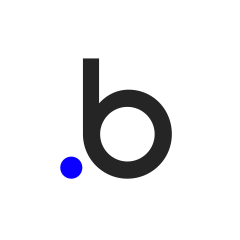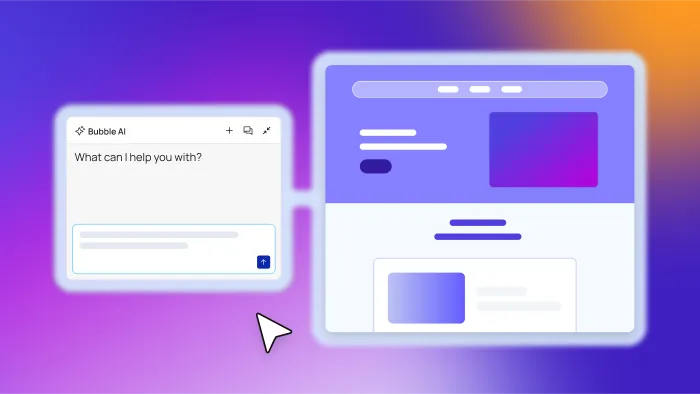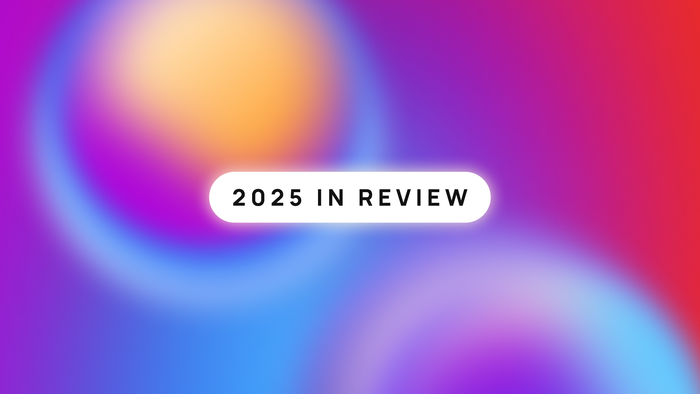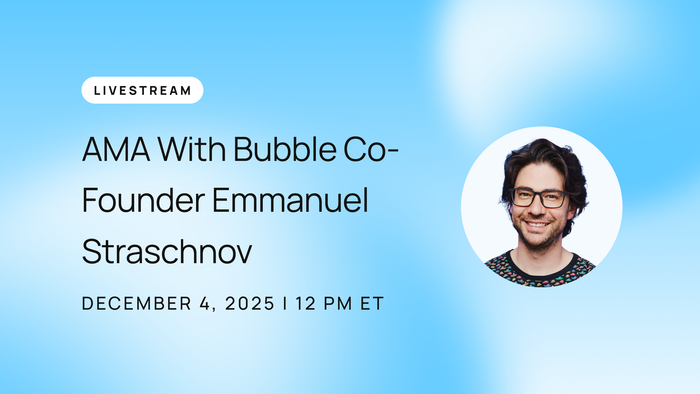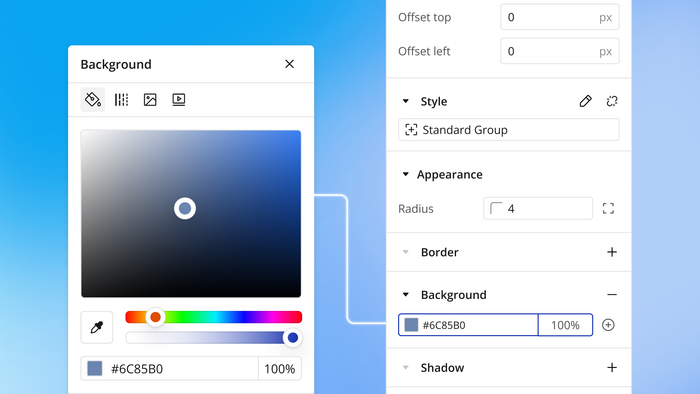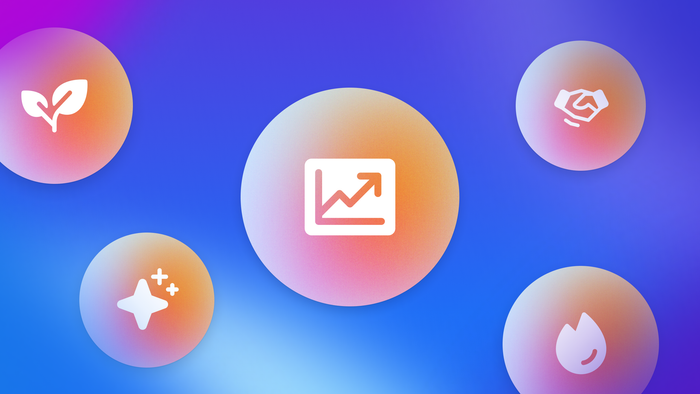Is AI overturning SaaS (Software as a Service)? After all, if everyone can just generate a custom app with AI, why pay for a subscription to one?
The truth is far more nuanced.
The SaaS industry is still growing — in part because building and maintaining apps and custom software, even with the help of AI, is a major undertaking. In fact, spending on SaaS applications per employee now averages $5,607, up 7% from 2023.
The next major disruption in SaaS development is likely to come not from the tech bubble, but from beyond it — with individuals and entrepreneurs using AI and no-code tools to create super-effective, highly-niche products to solve problems for a community that an “outsider” to that community would never see.
And, as audiences for SaaS platforms get more niche, you need a faster, more flexible, and less resource-intensive development process to serve them and make the unit economics work.
Bubble makes building, launching, and scaling a SaaS app easy for anyone — whether you’re looking to build the next SaaS unicorn or taking a great idea to a limited audience but still want to support a viable, profitable company.
In this article, we’ll show you how to choose the right software development process for your goals and walk you through the SaaS application development process step-by-step.
AI, no-code, or traditional development: which route’s right for your SaaS app?
The question of which SaaS app development process is right for you comes down to a few factors, namely: cost, experience, time, scale, and security.
| Traditional development | AI vibe-coding | AI + no-code | |
|---|---|---|---|
| Overall best for | Teams with existing resources who want full control and freedom and have very exact, custom specifications. | Prototypes and MVPs, testing out ideas. | Fast and effective development with full control, small teams who need to move fast, bootstrapped founders and individuals |
| Cost | Very high ($100,000+)td> | Low (cost of tool + tokens, $80 - $500 for MVP) | Low (cost of tool, monthly subscription typically <$50) |
| Experience level | Very high (experienced coding in specific programming languages necessary) | Low to get started, medium - high to finish more complex projects | Low–medium, no coding knowledge needed, just need to familiarize yourself with the no-code platform |
| Time | Long timelines, apps can take months to years to develop | Very fast, MVPs can be done in hours, fully-functional development can take weeks | Fast, fully-functional V1s can be done in days or weeks |
| Scale | Unlimited | Dependent on the AI platform and hosting, requires more experience to scale | No-code platforms like Bubble offer built-in scaling options, offering nearly-unlimited scale |
| Security | You are fully responsible for security, and can make your app as secure as you want. | Security can be a major problem with AI-built apps, unless you have the experience to hard-code custom security options. | Security and privacy settings are also built without code, so anyone can make a secure app. |
Traditional software development is best for large teams with exacting specifications for whom time and money are no object. Yes, you can build exactly what you want — but you also have to hard-code every piece of your app basically from scratch, which takes a massive amount of time and (expensive) resources.
AI tools are best for individuals who want to test out ideas, create prototypes, or have a semi-functional MVP (minimum viable product) to show off for fundraising or finding a co-founder. They are extremely fast and cheap to get started with, and don’t require any experience to whip up a prototype.
The downside of trying to code with an AI app generator is that building a business — not just a prototype — requires more than convenience. It also requires control, data security, and true accessibility: not a black box who sometimes does and sometimes doesn’t understand what you want.
With AI coding app generators, you can often get 80% of the way complete in minutes. But that final 20% of dealing with important bugs, privacy settings, weird design quirks the AI created, or features that don’t quite work? You’re on your own, or often stuck in endless prompt loops without getting what you want.
For example, this SaaS software developer tried using ChatGPT and Bolt to develop a SaaS app. He did it (in less than five hours!), but he also found several downsides:
- AI tools couldn’t see or read his codebase, making iterations and updates difficult. If you don’t know how to read or understand the code the AI is generating, you’ll be stuck (because the AI often can’t see it either).
- Sometimes the AI got stuck in loops, or told him it fixed issues it hadn’t fixed.
- It would often take minor requests (i.e. “change this header”) and make major changes (i.e. erasing the entire table and rebuilding that section of the page), burning through tokens and sometimes deleting pieces of his app that previously worked fine.
“All of this would cause me to burn through tokens costing me money, which got worse as the project got bigger. My experiment was beginning to turn into a bit of a casino where I was pulling the arm of a slot machine trying to get the coins to line up, or rather, squash the bug. Another $20.00 token reload please cashier.” — Stu Green
AI visual development platforms land somewhere between these two options. Like AI tools, they’re incredibly affordable, more accessible, and way faster than traditional development. But like traditional coding, the best no-code tools offer control, security, and customizability. You don’t get stuck in endless prompt loops; instead, you’re given the power and control to build exactly what you want, how you want it — just without code.
“I was seeing eye popping numbers — tens or hundreds of thousands of dollars. I figured there had to be a different way that I could get this built quickly for not nearly as much money just to get my idea out there. The Bubble subscription plans are so reasonable that it was kind of a no-brainer.” — Renee Jackson, founder of Dyspute.ai
Bubble vs. other no-code tools
If you’re leaning toward no-code, keep in mind that — like AI app generators — not all no-code tools are created equal. For example:
- Webflow and Wordpress are super customizable and easier to learn, but they’re best for websites and don’t have built-in data solutions.
- Caspio and Flutterflow both offer no-code, full-stack solutions, but are quite expensive and have steeper learning curves.
- Softr and Glide are easier to use, but have less customization options.
Traditionally, no-code has always involved some trade-offs between expertise, customization, and versatility. But at Bubble, we think about no-code differently: less of a platform, more of a visual programming language.
On Bubble, you get full control over the design, data, and functionality of your app, all in one tool, and all without coding. Bubble also offers platform features necessary for SaaS app development, like:
- Integrated AI-powered app generator to get your MVP foundation built in minutes
- SaaS templates so you can start with a ready-made foundation and simply customize for your needs
- No technical expertise required to get started
- Fully visual, drag-and-drop editor puts you in full control of iterations
- Built-in Stripe integration for subscriptions and one-off purchases
- Plugins to integrate with other tech, including other SaaS tools
- Options to add AI features to your app via plugins or the API Connector — still without coding
How to build a SaaS app with AI and no code
Successful SaaS application development — whether it’s for your own team to use or to start a business — doesn’t have to require a ton of time, expertise, or resources.
In this guide, we’ll show you how to build a SaaS app — without coding — using Bubble, an AI-powered visual development platform.
Prefer to learn by watching? Binge our Bubble for AI Builders series, where Gregory John walks you through every step of building an app on Bubble with AI:
Step 1: Validate your idea
Jumping straight into building is tempting, and AI only makes it easier to whip up quick prototypes and MVPs.
But rushing into the building process without the necessary prep work is a mistake. If you haven’t validated your idea so you know exactly what you need to build, you’ll be slowed down in the long run with more iterations needed, lack of product-market fit, and slower growth.
Instead, start by refining your vision. The more clarity you have, the easier (and faster) building will be. You should define your:
- Target market (the who). Who is your app for? What are their needs, goals, pain points? Why do other solutions not work for this group?
- Problem to solve (the what). What are users going to be able to do with your app that they couldn’t before? What problem exists that your app will eliminate?
- MVP functionality (the how). How will your app work? What are the key features and functionality it will have to solve users’ problems?
- Value proposition (the why). Why is your app a good solution for the problem? What’s the main benefit of using your app?
- Main competitive differentiation (the why us). Why are you any different from competitors, or other solutions available? Why should your audience pick you to solve their problems?
Step 2: Choose your monetization model
Most SaaS apps use a subscription model for monetization.
Subscriptions as a business model is simple: users pay a monthly (or annual) fee to access the product, and you have recurring revenue to continue building and maintaining the app for those users.
But it’s not the only monetization model available. You could also consider:
| Monetization model | What it is | Pros | Cons |
|---|---|---|---|
| In-app purchases (coming soon to Bubble) | Users may pay for premium templates, features, elements, stock photos or graphics, or plugins, even if the product itself is free. | Users get free access to the tool (great for customer acquisition) and only pay for “what they need.” | Can become costly for power users, who are typically your most valuable audience segment. |
| In-app ads | Often used as a “freemium” model, users can choose a free plan with ads, or pay for a premium version without ads (think Spotify). | Relatively easy way to monetize, and incentivizes users to sign up for a paid plan. | Revenue can be unpredictable. |
| Paid apps | Users pay a one-time fee to “purchase” the app or software for download. | Simple strategy for consumer-focused apps with few updates, easy for the user. | Lack of a free trial can hinder growth; for more complex SaaS apps, one-time fees don’t always cover ongoing maintenance costs. |
| Hybrid monetization | Uses a combination of the above strategies. For SaaS, typically a subscription model with in-app purchases or ads. | Gives you “the best of both worlds” of various strategies, provides options for your users while also maximizing revenue. | Can be more complicated to set up and forecast revenue. |
Step 3: Determine core features
If you’ve done steps one and two, this step should be simple.
Your core features are determined by:
- Your core problem: What features you need to solve this particular problem for this particular user base (step 1)
- The competitive differentiators between your app and other solutions: What does your app need to have that others don’t (step 1)
- Your monetization method: Features like shopping, billing, or purchase management to monetize your app (step 2)
Besides your unique core features, there are some foundational features that every SaaS app needs, such as:
- User authentication, to allow users to log into your app and see their data
- Billing and account management
- Ability to add and edit user data
- Dashboard, for viewing and editing their app data and tasks
- Responsive design, to make your app functional on a variety of screen sizes
Step 4: Build your MVP
With your idea and core functionality solidified, you’re ready to start building.
Traditionally, this stage of the process could take months or years and cost upwards of $100,000 — but with Bubble + AI, this stage of the process can be done in hours or days, on your own.
Start by prompting Bubble AI. This is the quickest way to get a foundation of your app in place. You can then iterate from there, without having to spend a ton of time on the basic pieces of your SaaS platform.
For our example, we gave Bubble AI the following prompt:
Bubble AI takes about 5-7 minutes to generate the MVP of your app, and then brings you directly to the editor to preview and iterate on your app.
Preview your app. In the editor, click the “play” icon in the nav bar so you can review the AI output. You’ll likely be pleasantly surprised by how far AI can get you — but you’ll also likely see plenty you want to change or add, too.
From preview mode, go through each page and feature of your app, focusing on three key areas:
- Design (how your app looks)
- Data (what information your app can hold)
- Logic (how your app works)
For each of these areas, look for what’s working well, what’s missing, and what needs to change in some way. For example:
- Does your app look the way you want it to? What styles or design changes do you want to make?
- Does your app have the pages it needs? Are any pages incomplete or hard to find?
- Does every button and element work as expected? Are any features missing or not working properly?
- What data types or fields do you want to add to your app?
For our example, Bubble AI generated several pages for our app, including a basic dashboard, calendar, tasks, and progress page.
The design of the app looks pretty good straight from the AI.
As we click through the app, we can note what needs to be changed or adjusted, as well as what features already work (e.g., most of the buttons) and which features need additional work (e.g., the scheduling function.)
Step 5: Refine and finish your SaaS app
With our list of refinements in hand, it’s time to tackle each of those three core areas of your SaaS app: design, data, and logic.
This is the most time-intensive aspect of SaaS software development, but as many Bubble builders have found, it often takes much less time than they expect:
“The biggest surprise is that I was able to build this AI legal mediation [MVP] in 8 weeks. In my head, that was going to be a years-long process, and I didn’t think in a million years that I would be able to finish my product that quickly and have it actually work.” — Renee Jackson, founder of Dyspute.ai
Configure your app’s data
Data serves as the foundation for your app — but it’s mostly stored in the background. In the backend of your app, you’ll have a database (a library or catalog of all the types of data your app stores) and data types (individual “things” stored in your database, like “projects” or “tasks”).
For our example, Bubble AI generated the basic data types for us — appointments, calendar blocks, projects, tasks, and users. It also included the basic data fields within those types.
If you need more fields on a data type, just click Create a new field to add more.
If you want to add more data types to your app, the easiest way is to use Bubble AI. Click the Generate Data Types button and explain your new feature, and the AI will generate basic data types and fields to power that feature.
For example, we might decide to add a feature to this app that allows users to add team members and assign them to projects and tasks.
The AI then generated a “TeamMember” data type with a name and email field. We can add more fields (like “role”) or use it as is. We can also see that the AI added field types for “Assigned Projects” and “Assigned Tasks.”
We also need the other half of that — to be able to see assigned team members on “Tasks” and “Projects” data types. To add these fields, click on the appropriate data type (e.g., “Project”), then click Create a new field.
From there, you can set the field name (e.g. “Assigned Team Member”) and the field type (i.e., where is this data coming from? In this case, it’s from the Data type “TeamMember”).
Watch a quick demo of more ways to use data in your app:
Refine the design
Design covers the look and feel of your app — the overall design, the user interface (UI), and elements like buttons, headers, images, and so on.
The Styles tab gives you a one-stop-shop to adjust the overall look and feel of your app, such as setting up universal fonts, colors, and element styles.
Unlike many AI builders, on Bubble, you have full control over every aspect of design: from the colors, shape, size, and location of each element to the overall look and feel of your app, all down to the pixel. It’s all within your control, but you never have to code — just use the visual menus and drag-and-drop components to build exactly the app you had in mind.
You can edit the appearance of individual elements simply by opening their editor and using the Appearance and Layout tabs.
If you’re new to the world of app design, read our guides on web app design or mobile app design, or watch our walkthroughs on customizing your app’s design once you’ve built with AI:
Build out additional features and logic
Logic is what brings together your design (the visual side of your app) and data (the information in your app) to create functionality.
In short: It’s what makes your app do stuff.
On Bubble, workflows are the foundation of logic — and they’re designed visually, without code, too. They use a simple if this, then that structure.
For example, this workflow shows that when someone clicks the submit button on creating a new task, the app should “Create a new thing” in the database — a new task. It also defines what input data from the popup form the database should enter in each of the data fields under that data type.
Then, once the new database item is created, the app should close the task popup.
You can create new workflows directly from any element. Open the editor and click the Add workflow button, then use the “+” button to add actions to your workflow.
Sometimes, it’s easier to work on a single feature at a time, and carry it across all the categories. For example, let’s say you added a “Task owner” field to the “Task” data type while setting up the “adding team members to the app” example above.
With the new fields in place, you can go back to your UI in the Design tab and add input forms or places where you want that data to display. For example, you might edit the “Create a new task” popup to include an input box to assign it to a team member.
You can add an input box by dragging and dropping “dropdown” and “text” elements onto your canvas, or you can even copy and paste existing input forms.
Then, tell the app what to do with this dropdown. In this example:
- Placeholder shows the placeholder text that will show in the input box.
- Dynamic choices tells the app that it’s going to pull dropdown options from somewhere in your database, vs. from a static list.
- Type of choices tells your app what data type to use for the choices.
- Choices source tells your app where to find that data.
- Option caption tells your app what to display in that input form once a choice is made (in this case, the name of the selected option).
Now, when you preview your app, you’ll see this dropdown in place, pulling the appropriate data selections from your database.
Without any coding, you’ve linked your data (the backend) with your UI (the frontend) and added one more feature to your app.
Add plugins to expand your app’s capabilities
Another great thing about Bubble: you don’t have to build every feature from the ground up. Plugins allow you to integrate other tech into your app and add more advanced features more quickly.
For example, the AI tool built a calendar manually in our app. That’s fine for a prototype, but it’s going to be a lot to manage long-term. Instead, we can use a calendar plugin (look for the Plugins tab in the editor) and drag-and-drop in a pre-built calendar feature. In this example, we use the Full Calendar plugin.
Then, use the element editor to set up how it works and what data it displays — including features like editing by dragging and dropping or dragging to resize an event length.
And just like that: you have a fully-functional calendar feature with interactive functionality, without having to build it manually.
Plugins are also a great way to:
- Add other technology from your tech stack into your app, like integrating Stripe to collect SaaS subscription payments.
- Add AI features to your app, for example, adding an AI agent that could schedule my upcoming tasks onto my calendar based on priority.
- Allow users to integrate their external data to your app, for example, by adding a Google calendar plugin so users could link their Google calendar with this app.
Step 6: Collect feedback
You’ve built your app, and now, you need to make sure it makes sense for your users.
The best way to do that is through user testing. And there are so many different ways to do user testing (especially on Bubble!). You can think about testing your app in three layers:
- Product testing, aka Quality Assurance (QA) testing. This means checking to make sure every element, workflow, and feature works as designed. On Bubble, you can use the debugger, the issue checker, and, for mobile apps, Bubble Go to run QA testing.
- Usability testing. Usability testing looks at how users navigate and interact with your app, helping you make sure the app is easy to use. Typically, you’ll give users specific tasks to do using your app and collect feedback on how they accomplish them — and what their experience was of doing so.
- User acceptance testing (UAT). UAT is the last step of product testing before launch. The goal is to make sure all the details are in place so that your tool meets user needs, is ready for real-world tasks, traffic, and usage, and functions as expected for users. Beta testing with a closed group of users and in-app feedback are common ways of running UAT.
Step 7: Iterate, launch and scale
You might never feel “ready” to launch — so once all the major features of your app are in place and you’ve done your testing, get your app out in the world.
Launching on Bubble is simple: just click Deploy and Bubble will push your web app live. You can also launch mobile apps directly to the Apple App Store and Google Play Store from the Bubble editor, too.
Once you’ve launched, don’t stop testing and iterating! Feedback from real users will give you more valuable insight than any pre-launch testing can — so keep testing, iterating, and scaling.
Iteration on Bubble is a major benefit to building with no-code vs. using AI. Most AI tools only have two iteration options: prompt the AI to make the change, or make the change yourself with traditional code. If you don’t know how to code, your options are limited and you’ll find yourself hitting walls frequently.
On Bubble, you’re in full control the whole time. You won’t get stuck in prompt loops trying to iterate, but you also don’t need code. Any feature, element, design change, or workflow can be edited visually, so you can always understand how your app works and how to adjust it.
SaaS development challenges
No matter where you build, if you can plan for these common challenges with building SaaS apps before you start building, you’ll have a much easier (and faster) development process.
App security
With SaaS apps, users are logging in, storing personal — or business — data, and often sharing, collating, and managing data between apps in your tool. Security and data protection are musts.
When you’re building with traditional development, building a secure app is completely up to you. But in that case, at least you have experienced developers who (hopefully) know how to address your security needs.
With vibe coding, security issues are becoming common and can be destructive to a fledgling business. AI-generated code is not automatically secure — so if you don’t have the experience and expertise to develop privacy and security rules by writing it into the code yourself, you’ll need to hire an expert to help build and maintain a secure app.
Bubble knows that not every founder and entrepreneur will be a security expert — so we make it simple to build secure apps. On Bubble, you get:
- Secure infrastructure and hosting via AWS and with DDoS protection
- User authentication and access control including 2FA and permissions to manage who can access your app’s backend and how your users access your app
- State-of-the-art encryption for all your app’s data
- Compliance with all major data privacy standards, including SOC 2 Type II and GDPR
- Visual privacy rules and security settings so you can set up security for your app in an intuitive way
- Built-in vulnerability scanning on the Bubble Security Dashboard to alert you to any exposed data, compromised workflows, and other security issues before they become bigger problems.
Multi-platform development
SaaS isn’t just for work laptops anymore. Building SaaS apps often requires you to build for web, Android, and iOS.
AI and no-code for mobile development have typically lagged behind web development. But traditional mobile development is slow and costly — and requires you to rebuild your app for each platform (Android, iOS, and web).
At Bubble, we’re solving for this by building a true multi-platform development solution, allowing you to build for multiple platforms in one place. Better yet: your apps can share a backend, cutting down significantly on the amount of “rebuilding” needed. And best of all: you get true native mobile apps — not just web apps wrapped for mobile.
Integrations
SaaS solutions almost always require integrations with other tools and tech. For example:
- Connecting to Google Workspaces for email management or docs collaborations
- Integrating with LLMs for AI-powered assistants and features
- Integrating with Stripe or other payment processors for billing and subscriptions
- Syncing with other SaaS solutions like Quickbooks or Mailchimp for seamless workflows
Building these integrations yourself can require a lot of coding expertise. On Bubble, thousands of pre-built plugins give you quick access to the integrations and features you need. And if there happens to be something you can’t find? Use Bubble’s (no-code!) API connector to build your own connection and workflow.
Scalability
If you want to build a business, not just an MVP, you need more than a pretty design. You need a platform that can support real-world usage, traffic, and user data.
Scaling can be a challenge, especially with AI-generated apps and platforms. Traditional development makes this easier, but it also puts the responsibility on you to make sure your app is ready to scale.
Bubble offers a flexible, scalable solution that won’t limit your growth — no matter how fast or slow you grow. Plus, Bubble has a proven track record, with over three million apps built and scaling on Bubble.
Additional resources for building your SaaS app
No matter where you’re at on your building journey, Bubble is here with resources to make your next step just a bit easier:
Learn the basics:
- Binge the Bubble Basics for AI Builders to get up and running with your first app in just a few hours.
- Take a deep dive into the Bubble Youtube channel or Bubble Academy for complete courses or step-by-step guides to specific features.
- Find detailed docs on every Bubble feature in the Manual.
Get inspired to build your SaaS app:
- See how Marina Trajkovska built an AI-powered SaaS platform on Bubble, complete with an app walkthrough of Odyseek.
- Watch Bubble Developer Tomasz Wesołowski use Bubble AI to generate and iterate a remote workplace hub.
- Kickstart your creative juices with Bubble AI or Bubble’s SaaS templates to get your app started.
Find help and support from other builders:
- Check out the Bubble Forum for help with building in real-time.
- Need a hand? Work with an agency as a SaaS development partner to build your Bubble app.
Build your SaaS app on Bubble
With both AI-powered generation and visual development in your pocket, Bubble makes building your SaaS app easier, faster, and more secure, while giving you full control from start to finish. No matter what kind of SaaS app you want to build — or how big or small your audience is — Bubble gives you the tools, resources, and flexibility to make it possible.
Build for as long as you want on the Free plan. Only upgrade when you're ready to launch.
Join Bubble